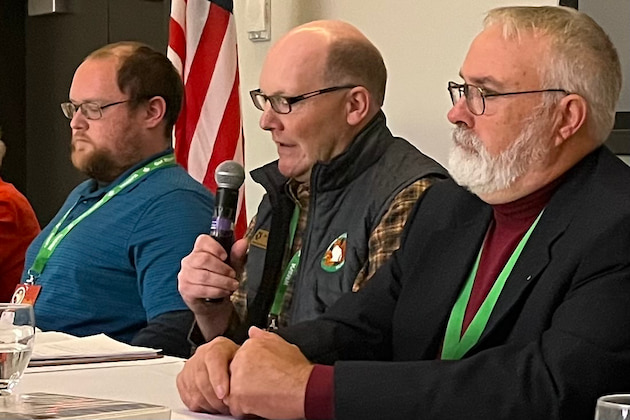Headlines
Industry leader panel says future of maple is strong
Improving marketing and production
By PETER GREGG | DECEMBER 17, 2022
LACROSSE, Wisc.—Industry leaders and experts had an upbeat message on the state of maple going into 2023.
“Markets are expanding and more syrup is being made than ever before,” said Matthew Bascom of Bascom Maple Farms during a panel discussion on the future of maple at the North American Maple Syrup Council annual meeting in LaCrosse, Wisc.
The panel featured Bascom, Wisconsin bulk buyer Steve Anderson, NAMSC president Howard Boyden, New York maple association director Helen Thomas and IMSI president Pam Green.
One of the big topics of discussion was pricing, on the minds of many sugarmakers who are dealing with rampant inflation in production input costs.
Overall the consensus was yes, sugarmakers should raise prices of syrup.
“It doesn’t make much sense to sell syrup at a loss,” Bascom said. “So if you need to go up, go up. We’ve got to farm the bottom line.”
Thomas said in New York, many sugarmakers are raising retail prices for syrup.
“We have no choice but to raise our prices,” she said. ‘People who have raised their prices haven’t caused a ripple at all.”
Green said consumer habits are not expected to change, despite an economic downturn.
“I think people who are buying syrup will continue to do that,” said Green, who makes syrup in Poultney, Vt.
Anderson made a point that in past economic downturns—the year 2000 and in 2008—syrup sales remained strong.
“In the past when we have had economic downturns, syrup sales have actually gone up,” Anderson said. “People stay at home more and cook more at home.”
Bascom agreed, “Maple is a comfort food.”
Anderson said the performance of maple in overseas markets is helping move more syrup through the system.
“Overseas markets are improving,” he said.
Bascom agreed saying that the foreign markets have improved 7 to 15 percent out of his operation. And the ingredient markets are also on the rise, “especially in California,” he said.
Anderson said that maple is being featured by “influencers” on social media who are using syrup for recipes and cooking.
“A lot of cool people are talking about maple,” he said. “We’re all on a rising tide.”
Thomas said the industry is more and more using creative marketing to promote maple.
“We need to focus on quality improvement,” she said.
Boyden said that one of the big challenges as an industry is to convince the shopping public to use maple on a regular basis, as opposed to only a gourmet item.
“We need to convince people to make maple a staple,” said Boyden, who makes syrup in Conway, Mass.
On the production side of maple, the industry has been robust, the experts said.
“Production will continue to expand but not necessarily the tap counts,” said Bascom, whose store in Alstead, N.H. is one of the biggest equipment dealers in the Northeast.
“One thing that is increasing is higher tap counts per tap,” Bascom said.
Boyden made an interesting comment that equipment makers and inventors need to come up with more “gadgets,” for production.
“A gadget to whip maple syrup into a marshmallow fluff would be great,” he said.
Thomas commented that the maple producing community is aging and expressed concern that not enough young people are getting into the business.
“The cost of start-up is prohibitive,” she said.
Boyden commented on the sustainability of maple.
“We ned to find out the limit of the trees,” Boyden said. “We don’t want to be the ones that over-milked the cow.”
Boyden also worried about the effects of a changing climate and invasive species.
“It used to be my father wouldn’t think to drill a tree until March 15,” he said. “Now I tap before Valentines Day.”
































